Small-scale harvest near Upper Hutt
Eric Cairns, New Zealand Tree Grower May 2019.
As many of you will know, I have been experimenting and advocating for continuous cover forestry for many years. Recently I chaired the NZFFA group looking at the economics of target diameter harvesting of even aged radiata pine. Unfortunately, our small pine block seen in the photograph above was too mature, too steep and too small to attempt selective harvesting of this nature. However, options still exist to carry out either small coupe or selection harvesting of eucalypts, blackwood and cypress in the future.
As I write this, our pine harvest was not quite complete, with about four truck and trailer loads to go. Some extra expenses were involved with harvesting the eucalypts, effectively clearing the site, and with making some tracks safe enough for heavy equipment to use.
Harvesting is not simple
I have been on an emotional roller coaster during and after the harvest. Export prices were at record highs, ultra-high pruning was worth it, but as to the resulting post-harvest carnage I feel guilty, although forests are resilient. Redwood stumps are already sending up coppice shoots and acacia and pine seedlings are thick on the ground.
There was a series of harvesting difficulties which were not apparent before work started −
- Additional earthworks were required to adjust the levels of the split-level skid site and make the main extraction route safe and some of this became additional costs
- Many trees leaning over the boundary were not harvestable
- Some trees were too big and dangerous to bring in off the steep slopes
- Mixed plantings of eucalypts and pines were too difficult to harvest at the quoted tonnage rate.
Problems to solve
During the work other problems arose. The 22-tonne excavator did more damage to the concrete driveway, the main access to our house, than the laden log trucks. The latter tended to compound existing cracks rather than make new ones.
When we had wet weather, one day of rain took three days or more to dry out sufficiently to allow the log trucks to work again. To save money we had not invested in enough large grade road metal to enable heavy machinery to move in all weather. In addition, the excavators brought a lot of dust on to the truck access which then turned to slush after rain. In addition, another time delay was when one of the machines broke down and it took three or four days to get the diesel turbo serviced.
The port at Wellington closed at the end of January and again in early March as log yards were full, waiting for a ship for our exporter. This restricted monthly income for the contractor and the bottleneck was compounded by the limited space available to stockpile logs at home.
Our lack of understanding the implications of extracting full length logs for processing created unrealistic expectations. Not only were trees felled into no-go zones, but the process of shovelling and tossing trees down the hill meant that fence lines we thought would be safe were trashed, and adjacent under-planting of alternative species were largely wiped out. The necessary upgrading and straightening of tracks to four or five metres wide was still not enough to prevent redwoods, cryptomerias and many others alongside the track from being damaged beyond repair. We should have expected this.
What we started with
To get back to the start. The pines were originally planted as agroforestry, Barr and Bunn style, starting in 1986 with groups of four seedlings at eight or 10 metre centres. The 1989 planting was with GF 16, dothistroma-resistant seedlings. Minimal thinning was carried out. Final stocking was variable but in the range 200 to 400 stems a hectare. About a quarter of the area was mixed plantings in lanes with the eucalypts nitens, regnans and saligna. About 10 years ago they were under-planted with redwood or cypress and cryptomeria. While most of the advanced regeneration under-planting was ruined at harvest, it is surprising how much survived.
The estimated harvested area was effectively a little over two hectares and the pines were between 30 and 33 years old at harvest. Due to close spacing, some less than two metres apart, a few pine trees became swept as they grew – the stems were not straight − but this appears to have had little effect on log grade.
This was a compact site, steep in places with a deep gully down the middle. All the logs were brought to the skid by shovelling which reduced soil compaction. Two excavators were used, one 16-tonne and one a bigger 22-tonne machine.
Our site is winter wet with heavy soils so the crop had to be harvested in the summer. Even in an almost drought there were still wet gullies with blue clay. Liberal use of corduroy was required to prevent machines bogging on the main track and to cross the stream. The narrow existing tracks needed substantial straightening and widening, as full-length trees were to be extracted.
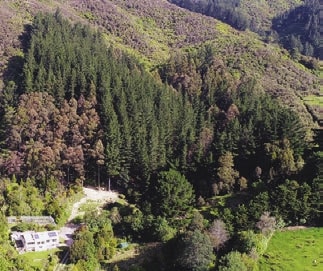
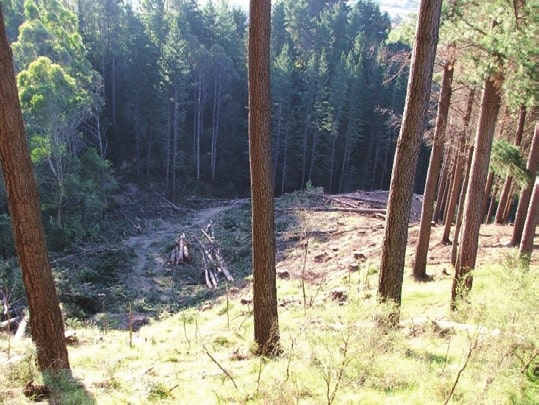
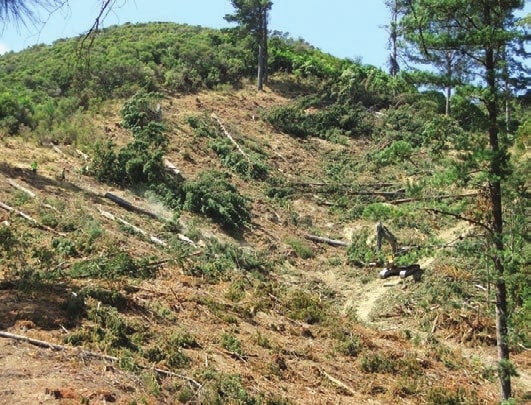
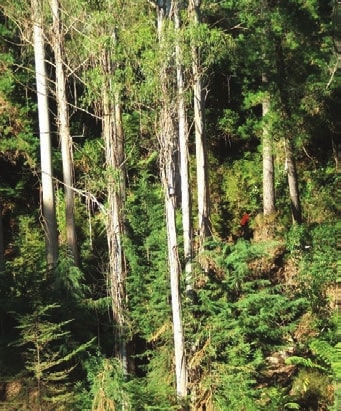
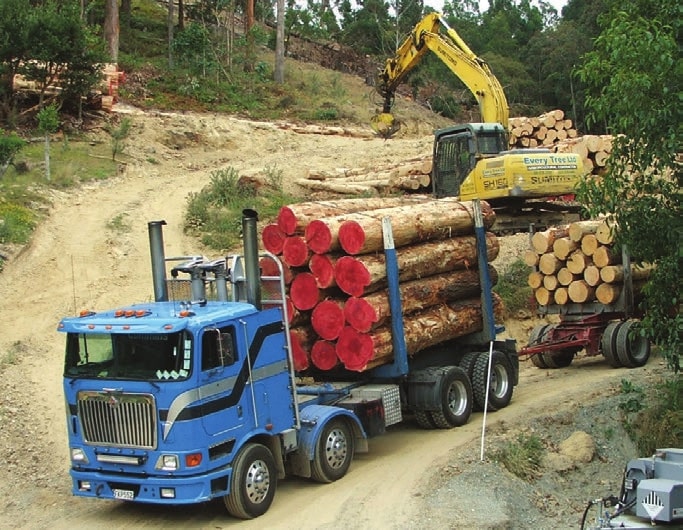
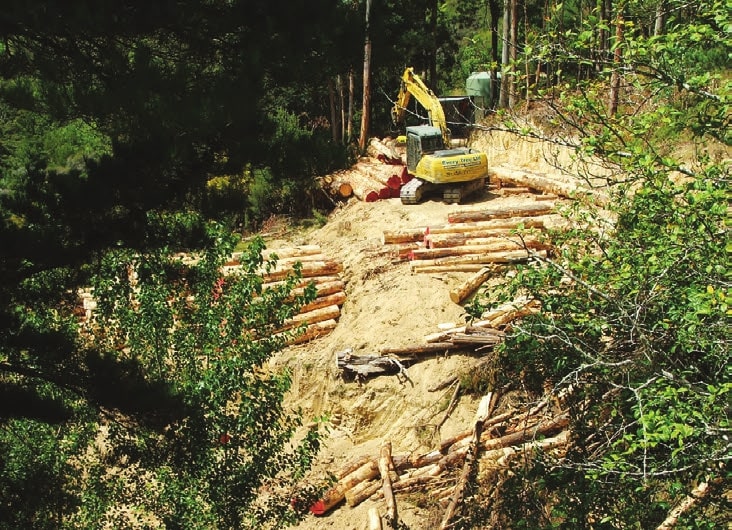
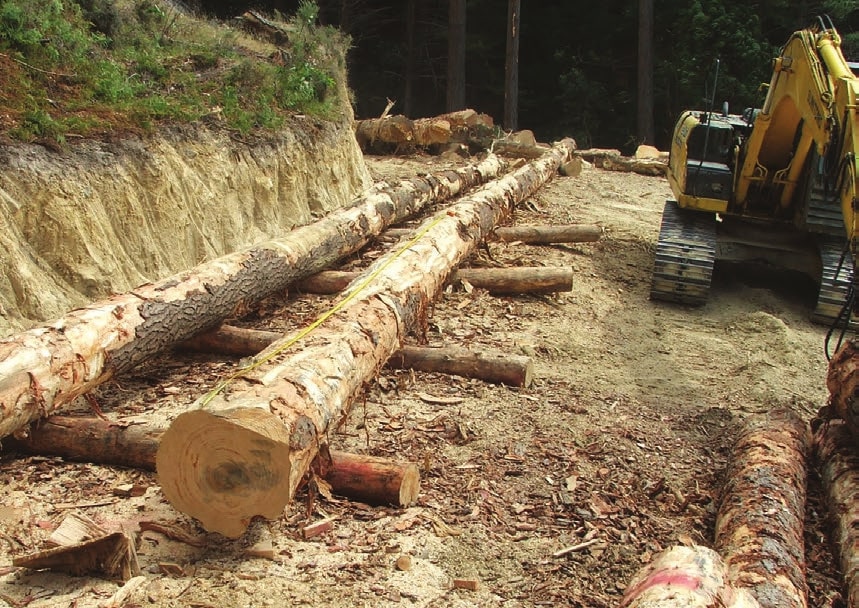
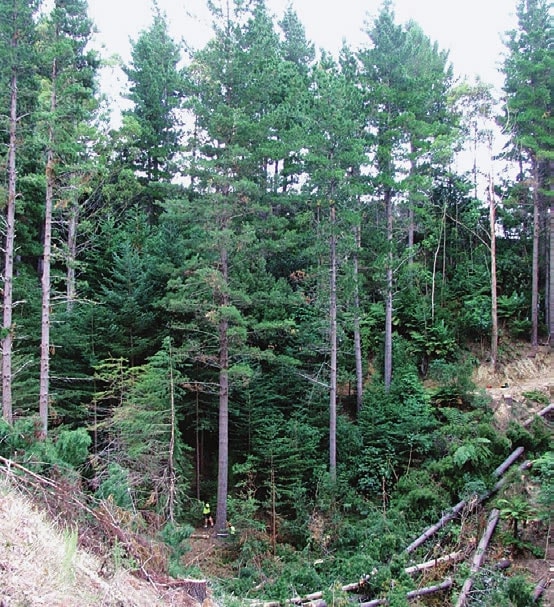
A dilemma
Trees in general were too big for the available equipment and steepness of site. A good number were 60 to 80 centimetres diameter at breast height and up to 45 metres in height.
A log truck with a 28-tonne payload was able to use the existing concrete drive which gave access in most of the weather but the final 25 metres to the skid site was usable only in the dry weather. There was minimal excavation for the skid site and tracks. Widening the existing track tended to raise the level rather than spill over the edge. Fortunately, we were able to harvest under old city council rules as the skid site was constructed before May 2018.
From the contractor’s point of view, the ideal piece size for pines would have been less than 60 cm diameter at breast height, but this would have resulted in fewer P40 logs and lower returns. Over 70 trees which were difficult to access were either not felled or not recovered because they were out of reach of the machine and would have needed an arborist. This represented 12 per cent of the crop and has resulted in something of a dilemma. Are the trees left behind a liability or an opportunity for habitat and edible fungi? I was not planning to re-establish with radiata pine.
Uneconomic eucalypts
It has been diabolically difficult and expensive to have ash group eucalypts mixed among the pines, even though they were in corridors. The eucalypts had negative nett value due to difficulties of harvest and low saw mill demand. Eucalypts cannot be safely felled by swinging across their natural leaning direction or crown weight so really need machine assistance for directional felling. Some of the trees were out of reach on steep sidings so were left standing
I decided to limit the negative effect of some of the eucalypts because the trees were stressed and unhealthy. I therefore paid daily rates to clear up the site so that I could portable mill some and use the rest as firewood.
The three days cost $5,200 to harvest yielding an estimated 80 tonnes.
Profitable pines
The pines were generally a success. Just over half the volume was pruned butts because many trees were pruned to between eight and 10 metres. Even those competing with the eucalypts grew fast enough. With broken tops not being recovered, the distribution of grades for export by JAS or Japanese agricultural standard was as follows −
- P 40 − 42 per cent
- P 30 − 10 per cent
- A grade − 32 per cent
- K grade − 8 per cent
- KI grade − 2 per cent
- KIS grade − 3 per cent.
Even with the 70 or so trees that could not be harvested or not able to be recovered after felling, the nett results look good to me. The two months of receipts available were for 999 tonnes of logs yielding a gross $157,000 or $80,000 after contractor and truck expenses. Extraordinary expenses such as the daily rate for clearing eucalypts and damage to the concrete driveway are not included.
The future
This site is too small and too steep to warrant a repeat pine forest. The small area would not suit bringing in a larger machine with feller-buncher head or a tethered harvesting machine. Therefore, what for the future?
The steep site should be in trees rather than pasture. I am very reluctant to let it all revert to native bush which in our area is likely to soon meet definitions for a significant natural area. Local body rules on such areas can be very restrictive and therefore the land owner would very probably lose control of their land.
Rather than convert it to pasture, I would like to retain or plant enough exotic trees, apart from indigenous riparian strips, so that it meets the definition of plantation forest. In my view, mixed forest can still have very high biodiversity value. We are proud of the dawn chorus and range of native plants that grow here.
What should we plant? Gorse, manuka and fern will arrive soon enough, along with seedling pines and ash eucalypts. Acacias are already germinating en-masse. I am keen on edible fungi and have a renewed interest in oaks. How much land can reasonably be turned into an arboretum or park like environment? All this will require new fences and sheep grazing to help control the fire danger. It is looking like another four hectares of arboretum coming on.
At some stage in the next 15 years we will be selling up and moving on, so maximising real estate value will be important to our beneficiaries. Park-like surrounds with a network of foot tracks and vistas and keeping options open for future subdivision would make sense.
Eric Cairns was the winner of the NZ Landcare Trust Innovation in Sustainable Farm Forestry award in 2017.

 Farm Forestry New Zealand
Farm Forestry New Zealand